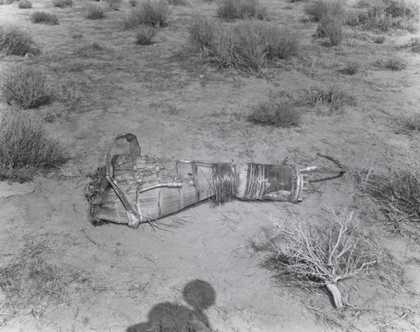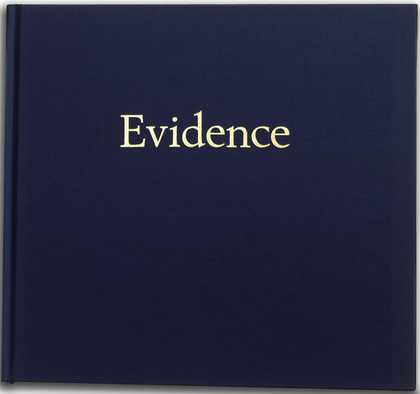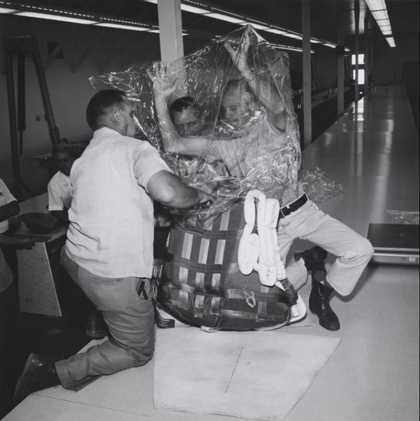In Larry Sultan and Mike Mandel’s captionless 1977 photobook Evidence there is a photograph of a destroyed rocket found on the ground in an inhospitable, arid desert (fig.1). The camera points down onto the scene as if to survey the extent of the wreckage. In the foreground, the photographer’s shadow can be seen at the extreme edge of the composition, amid the dust and rubble, such that the view shown resembles a crime scene. In a contradictory sense, the content of the photograph is both destroyed and conserved, built up from a collection of interwoven traces: the skeleton of a destroyed rocket, the shadow of the photographer, and sand and ash strewn across the floor. Shot in the military hinterlands of the California desert, a testing ground for what was then the latest military and aeronautics machinery, the photograph suggests an almost incinerated photographic reality.

Fig.1
Larry Sultan and Mike Mandel
Untitled 1977, printed 2001, from Evidence 1977
Tate P14494
In the spring of 1977 Sultan and Mandel, two recent MFA graduates from the San Francisco Art Institute, self-published Evidence. The book was assembled from found photographs collected from the archives of seventy-seven aerospace weapons and energy corporations and research bodies located mostly on the California coast. Sultan and Mandel took two and a half years to complete the project, and during this time they looked at over two million photographs. By the end of their research the pair had collected more than five hundred images that were eventually sequenced down to fifty-nine in the final edition of the book, thirty-six of which are held in the Tate collection as individual gelatin silver prints on paper that were printed in 2001 and 2006.1 The participating corporations for the photobook included General Atomic, Bechtel, NASA, the US Navy, Stanford Research Institute, TRW and Lockheed, among many others. In addition, the two artists also visited a number of public photographic archives, such as Pacific Telephone, Pacific Gas and Electric Company, Metropolitan Water District of Los Angeles, as well as the police and fire departments in the Bay Area. The first institution they visited was NASA’s Ames Research Laboratory. During the later stages of the project the duo left California and briefly visited the photographic archives of government buildings in Washington, D.C.
To gain access to the archives, Sultan and Mandel wrote to each institution using the stationery of Clatworthy Colorvues, the mock corporation that they had founded in 1974, and attached letters from National Endowment for the Arts and the San Francisco Museum of Art (later renamed San Francisco Museum of Modern Art, or SFMOMA). Since the majority of photographs that they were permitted to see were small 4 x 5 inch contact prints, Sultan and Mandel were able to view thousands of photographs in one sitting. During a marathon viewing at the Metropolitan Water District of Los Angeles, for instance, they looked at over 400,000 images.2 In Evidence the acknowledgements for the participating corporations, research institutions and state organisations stretches over three pages.

Fig.2
Larry Sultan and Mike Mandel
Front cover of Evidence 1977
Shortly after the publication of Evidence the project was exhibited at the San Francisco Museum of Art. In the show, which ran from 23 March to 8 May 1977, eighty-nine photographs were shown in five groupings (labelled A, B, C, D and E), in contrast to the more selective fifty-nine sequentially ordered images that comprised the photobook. To underscore the fact that their photographs were not fine art prints of the kind collected and exhibited by museums at the time, each one was displayed without a frame on plain glass cut to the size of the image. Financed by the National Endowment for the Arts Photographers Fellowship Program, the photobook was case-bound in buckram blue cloth and its lettering was printed in gold legal font to appear as though it had been bound by the UC Berkeley Law Library (fig.2).3 When the book was first launched and sold in bookshops and museums it was, unlike most fine art photography books at the time, presented without a dust jacket.4
Structuring Evidence
The photographs included in Evidence assume a chameleon-like status – photographs that could easily blend in among police procedurals, legal papers or other official documents. On a technical level, the majority of the photographs were shot with a large-format 4 x 5 camera, composed using a tripod and often illuminated by a striking flash. It is for these technical reasons that many of the photographs included in the project appear staged for the camera. The photobook in particular looks authoritative and official – ‘as hard as nails’, as photographer Robert Cumming once stated – since each design decision, from the book’s binding to its typography and layout, was made to underscore the illusion of a factual, objective assembled sequence.5 Throughout their project, Sultan and Mandel continually emphasised the authoritative and official qualities of their gathered imagery to question the very nature of ‘evidence’ and its relation to the genre of documentary.
The images assembled in their photobook were published in sequence, two to a page, without captions or explanatory text. These photographs – both those selected for the photobook and those shown in the exhibition – featured the strange, the banal and the catastrophic. Each one was sourced, assembled and re-sequenced from a series of corporate documents salvaged from what Sultan called ‘the dustbin of history’.6 Although the content of each of the images appears relatively clear within the sequence, the context surrounding each one – its origins and former function – remains altogether obscure. The original instrumental uses of the image – whether for scientific experiments or forensic investigation – were jettisoned in this new context. When Evidence is read in sequence from the first image to the last, each photograph appears so bewildering and disconcerting that the work seems to resist interpretation. It is as if the images contradict their own evidentiary nature and status – a nature and status associated with technocratic reason, truth and objectivity.

Fig.3
Larry Sultan and Mike Mandel
Untitled 1977, printed 2001, from Evidence 1977
Tate P14492
On the whole, the world pictured in Evidence is one made up of strange machines, weird objects and perplexing subjects. One pairing, for instance, shows a photograph of a man operating a control tower placed next to another in which an individual covers two other men in plastic film wrap (fig.3). A subsequent pairing features an image of a group of men wading through a foam-filled landscape alongside another that features an enormous plastic spider-like structure. At first glance, some photographs even appear altogether unclassifiable: whether it is a man exiting an underground corridor or another with wires connected to his body. Although these images initially seem inexplicable and ambiguous, when read in sequence they ultimately appear purposeful and considered: photographs of controlled explosions as well as forensic images of investigation, detection and clue-gathering. Assembled in the lingering shadow of the Vietnam War (1955–75) and in the wider context of the cold war, Sultan and Mandel’s Evidence dramatises the way in which the past was viewed as a problem, even as a persistent source of discomfort and unease. Although on the surface Evidence appears empty of any logic or meaning, the work is in fact about the presence and persistence of catastrophe. What this In Focus will show is how cold war anxieties concerning the subject’s relation to the future were just as much anxieties expressed in relation to the status of the past.
Narrating ‘truth’
What makes Evidence unique, particularly in the history of photography, is the way in which it questions how photographs operate as evidence. The instrumental use of photography in the realm of forensics, for instance, acts on the assumption that there is an underlying ‘true’ narrative to be unearthed and that the marshalling of facts – the mobilisation of photographs as evidence – is key to unlocking this condition of truth.7 Within the field of forensics, photographic evidence acts as both the trigger for an investigation and the opening through which the narrative plays out.8 Sultan and Mandel’s Evidence complicates this condition by continually sowing doubt in the mind of the viewer. The project is premised on the idea that there is no ‘neat’ or ‘true’ evidential narrative, nor is there any ‘straight’ or ‘clean’ form of evidence prior to its staging. The expression ‘just the facts’ seems inadequate in this respect. The staging of evidence – which Sultan and Mandel are always at pains to show through their emphasis on photographic framing – demonstrates how the very interpretation of ‘evidence’ is situated within a predetermined, and overdetermined, framework. This ‘framing’ of evidence led the photographer and critic Allan Sekula, in an essay published around the same time as Sultan and Mandel’s Evidence, to assert that the courtroom is always ‘the battleground of fiction’.9 The image of evidence, then, is less the work of ‘objectivity’ per se than that of fictional and political manoeuvring.
Throughout their sequence Sultan and Mandel highlight how evidence is framed and staged comically before the camera. By omitting the caption, not cropping the photograph and therefore emphasising the framing of the image, and placing each photograph in a new sequential relation, Sultan and Mandel release the photograph from the frame in which it is situated. This procedure acts to expand the capacities and potentials of the images, but also comes to divest them of their original evidentiary function. By working through the strategies of montage – most notably succession and simultaneity, delay and anticipation, continuity and discontinuity – the work makes it possible for other tracks of interpretation to be pursued. Discussing the modernist photobook and its ‘social form’, historian of photography Blake Stimson has described this experience as a type of ‘seeing’ premised on photographic seriality, sequence, juxtaposition and repetition, as can be seen in earlier photobooks such as Walker Evans’s American Photographs (1938) and Robert Frank’s The Americans (1958).10 Evidence acts as a thinking machine in its ability to construct alternative models of thought outside of the realm of technocratic reason and instrumentality.11 The project is premised on a peculiar contradiction: as the evidence accrues and grows, the more the ‘truth’ of the project is obscured and elided, and yet the more persistent the viewer will be in his or her desire to interpret the evidence.12
In Evidence interpretation is continually stifled or blocked by a variety of strategies: the absence of captions, the omission of an explanatory essay, the separation of named institution from photograph (the names are given only as a list in the acknowledgements), the erasure of the geographical specificity of the photographs, the omission of isolated sections or chapters, the drift towards abstraction in form and content, the inexplicable actions of each subject, and the otherworldly quality of the technological machinery. The overall effect of these elements is that the work seems to hover in a meaningless realm of free-floating signification. In a sense, Evidence appears incapable of passing judgment; nevertheless, the work remains intent on indicting the concept of the document and documentary evidence as a whole.
The remainder of this In Focus is split into four interconnected sections. ‘The Evidence of Images’ offers a critique of the dominant interpretation of Evidence that interprets it according to a model of the photographic archive. I seek to read Evidence through the counter-archival elements that the artwork sets in motion, and will attempt to historicise Evidence by questioning why and how the idea of evidence was problematised at this particular historical juncture in the mid-1970s. ‘Landscapes of Science Fiction’ expands the discussion of Evidence to address its relationship with the genres of science fiction and the detective story. Sultan and Mandel claimed that the photographs of scientific fact included in Evidence ‘looked a little bit like science fiction’.13 This section will show how the project directly or indirectly alluded to an otherworldly environment of eccentric figures, inexplicable machines and alien landscapes through conjecture and allusion – stylistic devices shared with science fiction and detective stories.
The section entitled ‘California in Catastrophe’ analyses how a model of catastrophe propels Sultan and Mandel’s project. Catastrophe, understood as a single, homogenous disaster, became the byword for California in the 1970s as a place marked by spectacular forms of violence, economic recession, oil shortages, smog, overpopulation, drought and inner-city rebellion. My reading aims to show how Sultan and Mandel’s Evidence treats the bodies and landscapes figured in the project as transformed by the presence and persistence of disaster, violence and ultimately catastrophe, arguing that in Sultan and Mandel’s Evidence, catastrophe should be interpreted as the historical thrust of the project as well as the artwork’s extended argument. The final section takes the form of an extended interview with Mike Mandel, conducted specially for this In Focus on 25 March 2016, in which the artist discusses his and Sultan’s early career and influences, and offers new insights into the creation and possible interpretations of Evidence.
